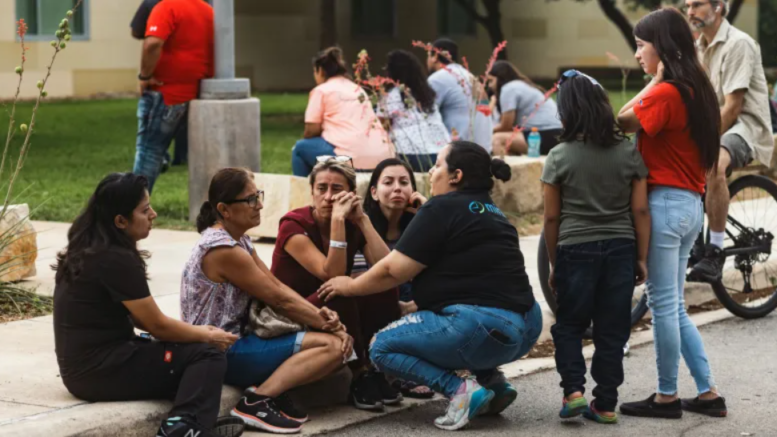Safe corridors for children traveling to and from schools. New scanning devices to catch weapons before they are brought into classrooms. A public information campaign urging parents to keep an eye on their own children and whether they have guns.
Those were some of the suggestions floated Wednesday by New York City officials at a press conference in response to the school shooting in Uvlade, Texas, where 19 elementary school students and two educators were murdered by a teenage gunman wielding an assault weapon-style rifle.
The horror of another massacre in America’s classrooms has again ignited debate about how to keep children safe while they learn.
In New York, where state gun safety laws are already stricter than many other parts of the country, Gov. Kathy Hochul Wednesday announced a push to raise the age for purchasing certain types of firearms (even while the Supreme Court seems poised to strike down a state law regarding where guns can be carried.) She also deployed state troopers to conduct daily check-ins at schools for the rest of the academic year, which runs through the end of June for many districts.
In New York City, the tragedy in Texas is likely to rekindle debate over metal detectors in schools, how safe campuses really are, and the role of school safety agents.
Meanwhile, students in New York City and the state are grappling with a string of high-profile violent incidents. Within the last two months, a man opened fire on a crowded subway in Sunset Park; multiple shootings have taken place outside of schools, including one that claimed the life of 16-year-old Angellyh Yambo; and a white gunman motivated by racism killed 10 Black shoppers at a Buffalo grocery store.
The mayor and chancellor reiterated their support for hiring more school safety agents, with staffing far below previous years. Mayor Eric Adams stood by his plan to stop the transfer of responsibility over school safety agents from the New York Police Department to the education department, a move that disappointed many advocates who argue that police department employees should not be stationed in schools.
“We have some of the best school safety agents,” said Adams, who served for decades as a police officer before becoming mayor. “They’re going to stay in coordination with the police department. And we’re going to make sure we stand with the chancellor to get to the numbers that we need.”
New York City police officials highlighted an alarming jump in weapons being confiscated in schools, increasing to more than 5,500 this year from almost 2,400 in 2018-2019. Twenty firearms were found this year, up from 5 the previous year, according to police. Police officials did not provide figures for a pre-pandemic comparison nor did they answer a follow-up question about whether there has been an increase in scanning for weapons or other enforcement changes that might explain the bigger numbers.
But if campuses have become more violent, that is not reflected in the number of times students were suspended, which is down this year. And a big portion of the increase in weapons being found are from contraband that the police department labels as “other,” but that officials declined to identify. Likely included in that category are items like pepper spray, which Chancellor David Banks argued students are carrying to protect themselves outside of schools – not in them.
“They don’t feel safe in the streets. They feel that they are under duress. There are threats that are made against them,” Banks said of the city’s students. “And they’re saying to us, ‘I’m trying to protect myself so I can make it home.’”
In response to a question from a reporter, Adams said he would consider establishing safe passage routes to protect students on their school commutes. His predecessor, former Mayor Bill de Blasio, announced the city would establish 20 such routes after a spate of incidents in which guns were found at schools. City officials did not answer questions about whether those passages ever came to fruition.
Banks also said he would meet with school labor unions and engage with families and students to collect their ideas for keeping campus and young people safe.
Adams implored the public to get involved in keeping guns out of schools. He said he would be recording messages to parents encouraging them to look for weapons in their own homes — nodding to an ad he created while a state senator that was roundly mocked.
“I’m not going to try to see what’s popular to address this. I’m going to be honest with parents,” Adams said. “You must see what your children are doing. And we want to have you as part of the solution.”
Even while the chancellor downplayed the role that metal detectors should play, he and the mayor said they are considering adopting new technologies to detect guns both on subways and in schools. Any such plan is likely to be met with concerns that the devices are used fairly, or that they even work as promised.
“No child wants to go to school to be scanned. You feel like you’re going to jail, just to go to your English class,” Banks said. “So we’re looking at technology that is much less invasive, still preserves the integrity of just being a student and going to school. But yet you can have the assuredness that nobody is walking into a school with a firearm.”
This article was originally posted on After Texas elementary school shooting, NYC officials ponder next steps

Be the first to comment on "After Texas elementary school shooting, NYC officials ponder next steps"